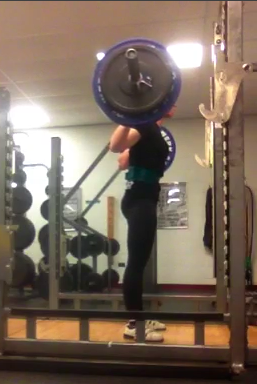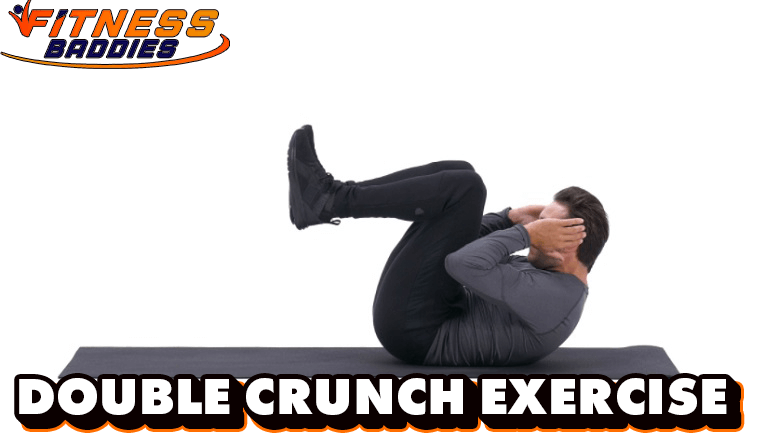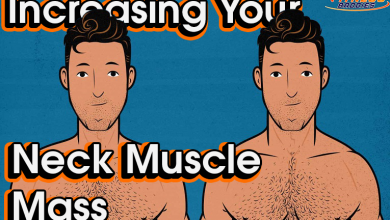My Squat Everyday Training Log: Average Lifter Gone Wild
Just over a year ago, I was stepping into brand-spanking-new learning territory about fitness, lifting, biology, neurochemistry, stress physiology, and training philosophy.

Around that time, you might have heard me say things about “squatting every day.” I had started delving into certain threads online regarding strength and conditioning, and I was exploring the concept/philosophy side of adaptation, programming, and performance. I began being much more interested in understanding the biological and chemical processes that occur and understanding the whole deal about the nervous system, fatigue, and practice. I had my training goal in mind. I wanted to learn how to squat really well. There were problems with this goal, but we’ll save those for later. I was asked if I wanted to join a private group coached by Matt Perryman as an experimental thing through Fitocracy. There was a private chat group that discussed a lot of different approaches and ideas about fitness, and the idea was that we could get together a group of people with similar interests about strength training to be coached by Matt Perryman.
Here is my very honest training log from those 9 weeks (12 weeks in actuality, but 9 in logs) over a year ago. To say I have grown in understanding and knowledge since then is an understatement! So much of what I learned from that time, I actually have “learned” now (better, at least). That is one reason I sat on this for quite awhile before sharing it. It was both a time of personal growth and of a lot of questions, and I felt it needed digestion. Matt has faded almost completely from the FB scene now (sure enough, he logged in the other day though). He is a graduate student of philosophy in New Zealand. He turned me on (or helped, at least) to the epistemology and philosophy side of training. His blog myosynthesis.com has some excellent reading.
Dealing in principles and knowing how to apply them is what makes for good coaching and good programs – not just knowing a bunch of exercises, or what muscle does what. That’s a part of it, of course, but it becomes a much smaller part in the long run (very small in fact). This program experiment was an education in principles.
I’ve included the Fitocracy links to see the actual sets and reps for those who are interested. Looking back, I trained pretty nuts, and that is obvious in my reports. I enjoyed it a lot, though clearly to train nuts, you have to take care of the other end. Not just sleep, food, yada, yada, but also workload, social obligations, stress, and overall mindset. You will clearly see where part of me was not pairing common sense with hard work. You will see me work hard, and work stupid. But part of the whole hard training process allowed me to learn how to work smarter, so I don’t regret it.
I am a stubborn learner. I do not say this with pride. Learning and applying critical knowledge rapidly is an important skill – one that I need to hone.
I am a hard worker. That I can say with pride, because it has allowed me to rack up more experience. Building better awareness and paying attention expedites that process. And I definitely could have used more of that.



Squatting Every Day is not a program; it is a training concept that includes both the “laws” of training and ideas about adaptation, neural drive, motor learning, and the acquisition of skill with lifting as the medium.
At the end of these logs, I will outline a couple of thoughts I have now about my training in hindsight in order to apply some context. I trained in this manner for 12 weeks, but only have 9 weeks of logs, some of which are a bit incomplete (missed logging a couple of days here and there). I was used to writing in my notebook for training, and doubling up on the writing in my notebook and logging on Fitocracy so Matt could see, and then getting the links right was a bit of a pain. Either way, if you are interested in the actual reps/sets and assistance work done, click on the Fitocracy links within the logs.
Disclaimer: Since I wanted to give an honest view of my training, I didn’t edit my language. Lots of cussing and reference to beer.
Matt gave us program guidelines and structured coaching concepts for us to apply this type of training. There are the basics. If you are interested, I recommend you purchase his e-book on Amazon, Squat Everyday. It is an excellent little book on strength and conditioning. It is not a “training” book, but more of a philosophy book about training. Good read for any lifter.
Matt’s individual involvement was limited. It was more of a group effort with his guidance (his words in Italics from our coaching doc):
“At some point, everyone has to learn how to train for themselves – taking initiative and making decisions from set to set, exercise to exercise. The program is almost beside the point once that happens. So that’s what we’re going to do here. We’re getting rid of “programs” per se. You’ll be learning how to train, rather than being managed. You’re probably wondering: If we don’t have a program, how do we know what to do. I want to be clear that “no program” doesn’t mean “no plan.” To me, a program means a list of strict rules that must be followed to the letter (or else), the way a bureaucrat manages an office.
“What we’re going to do instead is go into the gym with a strategy or plan of action. It’s just going to be a flexible plan, so you’ll never have to guess what to do next. You’ll always have a “theme” for any given day; only the details will happen as we go along. We’re going to be more like guerrilla revolutionaries, organic and always in motion.
“This is the concept of autoregulation, and as I instruct it, it centers on three principles:
1. Paying attention.
“The first step is just learning to be mindful when you train, which really just means “pay attention.” With that in mind I expect everyone to log RPEs along with their working sets. I want you learning to evaluate the overall quality of your reps, rather than trying to micro-analyze every last form cue, and getting in the habit of logging the subjective feedback from your sets is one good way to do this.”
2. Practice, Not Pain (as you will see, this was hard for me to get around in the long run)
“There is no ‘taking weight off to practice form.’ If your goal is to lift maximum weights, then there is no amount of practice at 60% that will help you do this. Form is skill plus load.
“The second matter is what constitutes quality. When I use that term, I am speaking as above in reference to ‘paying attention,’ on the presumption that your body knows (or at least has the capacity to know) how best to move for its own circumstances.
“Let me be clear: there is no abstract ‘perfect’ by which you can measure any given person’s ‘best’ movement. There is only better or worse relative to your build. Legitimate movement issues are a problem which we can address on a case-by-case basis, but often enough what appears to be a problem is better seen as a personal idiosyncrasy.
3. Smooth and Snappy
“The word here is ‘smooth.’ Each rep has some snap to it, rather than feeling like you had to throw a lot of effort behind it to make it go. Smooth, snappy reps – but still with a respectable weight on the bar – are what I’m going to call quality. (No grinders allowed. No failing reps allowed. 1RM’s for the day should end at 6/7 RPE, with 2-4 rep reserve.)
“How do you know when you’re reaching your limit for the day? When you look at the bar, how do you feel? Are you calm as reading the morning paper? Or did your heart rate jump and you started second guessing? You want to leave the emotion out as much as possible. Train calm. Relax.
“And ultimately training ‘cool’ is also a skill to be trained. The more you get used to doing this, the more natural it will become. Stay away from psyched-up monster lifts and get your work done in the chillout zone.
A quick rule of thumb that will guide you well: If there is doubt, you are done.
“If you look at a weight, get nervous, and have to ask yourself ‘will I hit this?’ then it is too heavy for you right now.”
He went on to cover other topics on tension and breathing, and he explained the meaning of saying “how you feel is a lie” (perceived recovered-ness or lack thereof was not a good indicator of performance abilities). He explained how to deal with pain: Pay attention to true warning signs, and don’t be a niggly whiner either. Additionally, we understood the importance of nutrition and that good movement fixes a lot.
The mantra for this style of training was: If there is doubt, you are done.
Even though biomechanically it was not “ideal” for my body at the time, it was one of the most valuable training experiences I’d had yet.
Included also in a second doc was an actual template for reps/sets and more details on warmups, assistance work, and specifics like that. I have to say, conveying these sorts of concepts to average fitness “buffs” is not easy, even if they are relatively experienced lifters. In hindsight, I was experienced if you looked at numbers, but my body was not experienced in terms of movement and certain strength qualities (another discussion for another day), so kudos to Matt for taking the time to start a few of us down this road. He certainly helped me a lot by virtue of exposure to a completely different way of looking at lifting specifically. It takes a lot of patience to bring someone through the education process, and THAT makes all the difference to the conclusions people come to and how they end up viewing certain things. It really is all a business in principles.
Below are the links to the Google Docs for you to view my logs for the weeks. I lol’ed a couple of times. Interspersed is some of Matt’s advice on certain issues. Training like this straddled the time I went to the Fitness Summit last year as well.
Week 1
Week 2
Week 3
Week 4
Week 5
Week 6
Week 7
Week 8
Week 9
At the end of the coaching group – the next day, specifically – I finally got my goal PR of 250 in my squat on May 20th, 2013.
You can see that here.
My little sticky note I had written at the beginning of the year came to life. It said: “Squat 250 by the end of the year.” Just a bit of satisfaction. I believe in the power of affirmations, written commitments, and visual reminders. They work for me, at least. There is a high correlation for me between writing something down and completing it, so I use that to keep me reminded. In the end, the best thing I got out of this program was not a squat PR, but a whole new perspective. That was worth the aches and pains and the frustration at times. No one could have given me everything I needed to know anyway, so what mattered to me was the environment that allowed me to learn it!
My PR came on a day I wasn’t expecting or aiming to peak for it, when I had less than an hour to train after coaching hours at the high school. But I stuck to the principles of the training template; it felt good, and I kept going.
It gave me a little taste of what I would later learn about competition and getting good performances out of people and information that the coaches at the World Athletics Center reiterated: Good performances are the result of good practices done consistently. You can’t pick the time and day that a PR will happen, but you can create the environment in which repeated excellent efforts in training are the norm. And then, you just pay attention and adjust. Dan Pfaff said: “Periodization (program, in this context) is nothing more than a lesson plan that leads to success for the “student” (me) on the “final exam” (PR lift).”
I am not comparing my personal squat PR to a world-class performance or a competition like the Olympics, which athletes do prepare for specifically. Let’s just not jump that far. I just think the concept for the training was the same, and it gave me a taste of a much broader and more holistic view for training – especially training with a specific performance goal.
Here are some lifting vids from that time:
Bulgarian Split Squats
20 Rep Squats
There are a couple more reasons I felt it would be valuable to others to share this time in my training in particular:
1.) Focused work has incredible power. Growth comes from conflict and often uncomfortable ideas and work.
You might cringe a bit reading some of my feedback and think “well, just fucking stop!” And while in hindsight I might agree, I can look back and see what I couldn’t see then about the process (which has made me a wiser coach). I went through it, and that’s the most valuable thing I could do.
Sherlock Holmes said: “It is easy to be wise after the event.” But what if you never did the event?
I also think the value of work in general is underrated. How do you expect to know the process if you don’t go through it? And then think about what you went through? If we know that the process is what matters, why aren’t more of us doing something? My friend Oliver Vadnais said it perfectly:
“I am of the belief that hard work equals success. So without the work, how can I succeed? I believe more in the work. The work allows me to believe in myself and the plan that is what I put confidence in. Not in the end result.”
This attitude can be a two-edged sword. So, be open to learning. How I look at training now versus a year ago is wildly different. It will probably get less “wildly different” as the years go on. That’s what experience and wisdom does. Or so I’ve heard. 😉
2.) Training is not about number, reps, and sets, and certain muscles. You have to train your mind as much as your body. You can’t separate them.
We all talk about smart work, but how can you realize smart work if you don’t know what unsmart work looks like? My hard work could certainly have been smarter, but part of that came from not having a bigger picture view. Work at your thinking as much as your training. Work at thinking about your training.

When you talk about a program you have done, or someone wants a recommendation for a program to do, there is an underlying attitude that needs to be gotten rid of: That there is something magical about programs.
Forget the program for a minute, with it’s exact exercises, sequence, and perfect percentages planned out. Think of the stimulus. Forget the exercise itself per se, think of the adaptation you require. People ask: Will this program make me lean? Will this program make me squat better? Will this program make me have gain size on my butt but not my legs? Those are the wrong questions. Spend your time understanding how the body adapts to stimuli.
When I started this program, my idea was: “If you want to be good at something, do a lot of it.” And that holds true. If you want to be a good lifter, you gotta lift. If you want to be strong you have to train in ways that make you stronger. If you want to be lean, you have to understand what happens in the body to lose fat. If you want to train with crazy volume, than you need to know what happens in the body as a result. If you want to compete in Crossfit, you need to understand the demands.
Understand the demands.
Your body doesn’t compartmentalize its processes and the effects you get. If you don’t realize that, you will forever chase a perfect program that doesn’t exist. You will also work hard and get nothing for it.
In hindsight, my body mechanically and movement-wise was not prepared for high-volume barbell squatting. I am also a bit special, because I am very hypermobile and – while coordinated (from dancing young) – I’m not naturally strong. I didn’t start off “strong” in the sense most people think of it. So when I started lifting, I compensated a lot through my joints and ligaments. Because of the hypermobility in my joints, I could get into all positions, but not with good motor control. No amount of barbell training was going to change that. I needed some good movement patterns ingrained first. If you get your movement down and are faithful to build that base, you will save yourself a lot of trouble. Some people are better at it than others. Some have years of body-history to work with. It really just depends.
Secondly, and this is for you ladies, I wasn’t obsessing about being lean. If you want to train hard, you need to eat for it! And you need to understand that it is a serious deduction you are making on your body’s “bank account.” Most women shy away from a couple of days of feeling bloated and never make any progress. My fellow coach Libby Wescombe talked about the recovery analogy in this blog post here. I see women use all kinds of programs and ideas with “fat loss” in mind. Sometimes they aren’t even fat! They want to look hard and toned, but are worrying more about the fact that they are soft. Of course you are! You won’t get harder and leaner from eating less. There’s nothing under that skin. Last I heard, bones weren’t toned. If you look at the pics above, you would not say I was fat in the least. Yet, in the back of our minds is this “get lean, get thin, get smaller” mentality that shoots us in the foot. First, it’s disordered thinking and untrue. Second, it keeps us in a twilight state where we never really gain or lose anything. Nothing really ever happens.
There’s also this great pic I tweeted the other day that illustrates the energy balance perfectly.

When you are a developing lifter, athlete, fitnesser, etc., you need structure. You need someone to tell you reps, sets, and rest. You need specific cues to get you in tune with your body and movement. You need rules to follow because you don’t know what you’re doing. You need enablers to help you pay attention and grasp what’s happening. This is how we learn. Exercise is your body learning. When you view it from that perspective, the whys and wherefores seem less daunting. You enter the flow of your own life and how your training fits into it. Eventually, your training is more your own. You have your arsenal of what you like to do, what gets your strong and makes you feel good, and what weaknesses you stay on top of. You are in tune with your movement and maintaining balance (which includes periods of overreaching). Your nose is less pressed to a tree, and you can start to see the outline of the forest. You feel less pressure to “get it right” and have an easier time being honest with yourself and your results and actually enjoying all this time sweating and wrestling iron. You are much more open to useful knowledge, because you are not blinded by “get lean, look this way, and have this squat number.” A good plan is nothing more than a hypothesis. A good plan starts you doing. A good plan is a good thing. But a piece of paper with pretty numbers doesn’t move the weight for you.
In conclusion, I will share Matt’s closing paragraphs of Squat Everyday because it has the essence of why I like training and why training is valuable and important to me and why I wanted to share this with you.
“Where the mind goes, the body can follow. No magic, no voodoo, no supernatural forces: just the conjunction of Self and Body.
When you switch off and ‘just be,’ you’re taking your cognitive self-regulation out of the process. You’re not getting emotional and setting off (or aggravating) the stress-response. You aren’t fighting against your body, introducing an artificial distance between Mind and Body. You aren’t thinking about the thing, forcing yourself to do it, or stressing out over minor details. You just go do it, and enjoy the act of doing.
Everything else flows from that.
External cues and structure, in the form of programs and training cycles and team mates, keep us on task, off-loading our decision-making needs and freeing up our self-control reserves. That’s important. The structure keeps you motivated and effortlessly focused. It’s why the Russians can train on systematic, methodical programs. It’s why others can thrive on autoregulated programs. It’s why still others need the comfort of exercise lists and spreadsheet-planned percentages.
None of these are right or wrong. All that matters is effectiveness.
These workouts aren’t just meaningless rituals or superstitions. They serve a purpose: they focus you and discipline you. Pre-workout rituals, training partners, teams, and coaches, even the habit of going to train all creates a structure that you operate within. Meditation, mindfulness, the flow-state, these all indicate that head-space where quality work is being done. These strategies are all about imposing a sense of order on your self.
It’s easy to forget this. Year after year, new fads spring up. Trends come and go. It’s easy to forget what a program or method is really about.
When you train, train. Don’t go through motions. Don’t train on feelings. Go in with intent. Whatever you do, make it work.
What you believe about your training matters. What you believe about your recovery abilities or the non-existence of recovery as a concept matters.
Train your body and train your mind, together, and you can surprise yourself.”
-Matt Perryman from Squat Everyday
Amen.

Achieve your nutrition and training goals with Joy’s expertise and support.
Get started now




